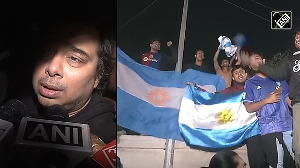 India-Vietnam relationship has its own imperatives and dynamism. In India’s look east policy Vietnam has been the major pivot, at least in terms of security and strategic imperatives, says Rup Narayan Das.
India-Vietnam relationship has its own imperatives and dynamism. In India’s look east policy Vietnam has been the major pivot, at least in terms of security and strategic imperatives, says Rup Narayan Das.
The general secretary of Vietnam’s Communist Party Nguyen Phu Trong began his four-day visit to India from Wednesday. In India’s ‘look east’ policy, Vietnam has been the major pivot, at least in terms of security and strategic imperatives.
Vietnam has been consistently supportive of India’s engagement with the ASEAN and its other outfits such as the East Asia Summit, ASEAN Regional Forum and ASEAN Defence Ministers' Meeting. While India has had cultural linkages with the Indo-China region, in modern times India has extended political support to Vietnam during its protracted liberation struggle and New Delhi had also been actively involved in the historic Geneva Conference of 1954 that brought peace, although elusive, to the region.
There was deep friendship and understanding between then Prime Minister Jawaharlal Nehru and Vietnam’s great leader Ho Chi Minh. The legendary military leader of Vietnam General Vo Nguyen Giap, who passed away recently, was also held in high esteem in India particularly by the leaders belonging to a Communist persuasion. In that sense, India’s engagement predates its ‘look east’ policy.
In recent times, however, India’s engagement with Vietnam has been elevated to a strategic level. There is also an institutional mechanism of the foreign office consultation and strategic dialogue between the two countries. There has been exchange of visits between defence personnel of the two countries from time to time. Naval ships from India have also been making port calls at Vietnamese ports. The Indian Navy has been supplying critical spare parts to Hanoi for its Russian origin ships and boats.
After Defence Minister A K Antony’s visit to Vietnam in 2007, both countries have engaged in joint patrols, and both navies participated in a joint exercise that year. India has also repaired and upgraded over 100 MiG planes of the Vietnam Air Force and supplied them with enhanced avionics and radar systems. Indian Air Force pilots have also been training their Vietnamese counterparts.
India’s foray into the South China Sea has indeed given a new twist to its engagement with Vietnam and to India’s ‘look east policy.’ There has been a perception that India’s foray into the South China Sea is a containment of China. The fact is that the cooperation between the ONGC Videsh and Petro-Vietnam goes back to the 1980s, which led to the signing of the production sharing contract between Hydrocarbon India Ltd, renamed later as ONGC Videsh, and Petro-Vietnam in May 1988.
Later, in June 2006 they signed the deal for the award of two exploration blocks, 127 and 128 in Phu Kan basin in Vietnam through regular bidding process. The latest agreement which was signed between India Vietnam in September 2011 during the visit of Vietnamese president is intended for developing long-term cooperation in oil and gas industry and shall be in force for three years.
Some of the key areas in which both the companies are desirous to cooperate are related to exchange of information on the petroleum industry, new investments, expansion and operations of oil and gas exploration and production including refining, transportation and supply in Vietnam, India, and third countries, according to laws and regulations of their countries.
Besides the state owned ONGC Videsh, private players like Essar Oil has been engaged in the oil exploration in the South China Sea. The OVL efforts to drill a well in block 128 in Vietnam were not successful due to logistic constraints in anchoring the rig on a hard sea bottom. ONGC Videsh earlier had abandoned block 127 after it failed to find any hydrocarbons there. OVL continues operations at block 6.1 in the same region, from where it got 2 billion cubic meters of gas in 2011-12 for its 45 per cent participating interest.
India has already made its position very clear with regard to it’s the South China Sea issue. It has made very clear that its engagement in the South China Sea is purely for commercial purposes. New Delhi is of the view that the South China Sea issue should be resolved peacefully by the countries concerned in accordance with the United Nations Convention on the Laws of the Sea. It, however, supports freedom of navigation.
There is a perception in some sections in strategic circles that India’s foray into the South China Sea is in response to China’s advances in the Indian Ocean and its infrastructural development in the Pakistan Occupied Kashmir, an issue of concern to India.
India’s nuanced position is that it stands for a cooperative, inclusive and rule- based security architecture that enhances collective security and regional and global stability. India-Vietnam relationship has its own imperatives and dynamism.
Image: General secretary of Vietnam’s Communist Party Nguyen Phu Trong
Rup Narayan Das is a senior fellow with the Institute for Defence Studies and Analyses. New Delhi.










